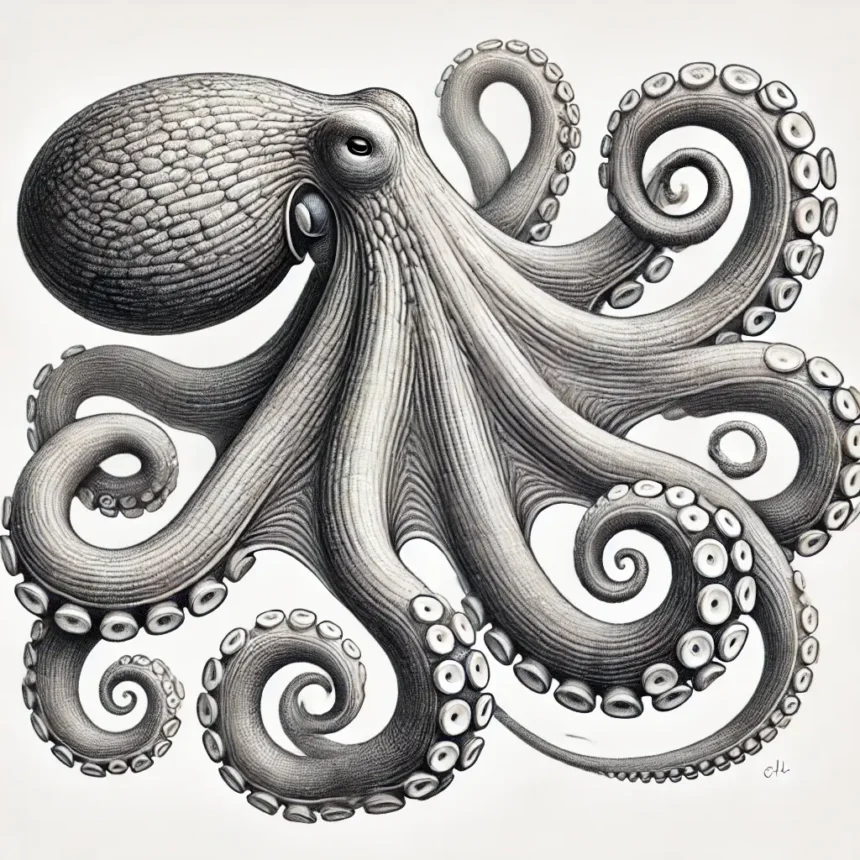Introduction to Octopus Drawing
Regarding ocean life, octopuses are among the most fascinating creatures. Their fluid movements, unique anatomy, and vibrant color patterns make them popular subjects for artists. This article will focus on creating a simple and beautiful octopus drawing that even beginners can enjoy.
Whether new to drawing or just looking to refine your technique, this accessible guide will help you create your octopus drawing.
Materials You Need for Octopus Drawing
Gathering suitable materials is essential before you start your octopus drawing. Here’s what you’ll need:
- Pencil: A standard HB pencil will work well for sketching.
- Eraser: To correct mistakes and clean up lines.
- Paper: Any drawing paper will work, but heavier-weight paper is recommended.
- Markers or Colored Pencils (optional): For adding color to your octopus drawing.
Step-by-Step Octopus Drawing Tutorial
Creating an octopus drawing can be broken down into manageable steps. Let’s go step by step to create your very own masterpiece.
Step 1: Drawing the Head
Start by sketching the shape of the octopus’s head. This part is relatively simple. The head resembles a large, oval, or slightly rounded shape. Making the head a bit longer rather than too round is essential. Once you’ve done that, lightly sketch the eyes on each side of the head.
Step 2: Drawing the Body
After sketching the head, move on to the body. Unlike many creatures, the octopus has no rigid body structure, so its body appears fluid and soft. Draw an oval shape below the head, slightly wider than the head, representing the mantle.
Step 3: Drawing the Tentacles
Next comes the fun part: drawing the octopus’s tentacles. Octopuses have eight long, flexible arms. Start by drawing one tentacle at a time, curving and twisting them to make the octopus appear dynamic. Make sure to vary the direction of the tentacles for a natural look. Each tentacle should taper slightly toward the tip. Draw at least eight arms evenly distributed around the body.
To make your octopus drawing look realistic, focus on making the tentacles appear in motion, as they are rarely static.
Step 4: Adding Details
Now that you have the basic structure of your octopus drawing, it’s time to add details.
- Suction Cups: Draw small, circular suction cups on the underside of each tentacle. You can make these larger near the base of the tentacles and smaller toward the tips.
- Eyes: Add more detail to the eyes by drawing small pupils in the center and adding some shading to make them stand out.
- Texturing: To give your octopus drawing a more realistic feel, lightly sketch texture lines on the body and tentacles.
Tips to Enhance Your Octopus Drawing
While the basic steps are essential, here are a few tips to help you take your octopus drawing to the next level:
- Study Real Octopuses: Look at photos or videos of real octopuses to understand their movement and structure. This will help you make your drawing more lifelike.
- Shading: Practice shading to add depth to your octopus drawing. Shading around the tentacles and head can make your drawing appear more three-dimensional.
- Experiment with Color: Try adding color once you are comfortable with your octopus drawing. Octopuses come in various colors, from deep reds to bright oranges and even blues. Adding color makes your drawing pop.
Common Mistakes in Octopus Drawing
Drawing an octopus can be tricky. Here are some common mistakes to avoid:
- Overcomplicating the Tentacles: While the tentacles are important, beginners often try to add too many details. Please keep it simple first and gradually add complexity as you become more comfortable.
- Inconsistent Tentacle Sizes: Make sure the tentacles are similar in size and proportion. If one tentacle is much thicker than the others, it can throw off the balance of your drawing.
- Ignoring Suction Cups: The suction cups are a crucial feature of octopuses, and leaving them out can make your drawing less recognizable.
FAQs
Q: How can I make my octopus drawings more realistic?
A: Focus on shading and adding texture to make your octopus drawings more realistic. Look at reference images of real octopuses to understand how light interacts with their skin and tentacles. You can also play with the position and motion of the tentacles to make your drawing look dynamic.
Q: What is the easiest way for beginners to draw an octopus?
A: The easiest way to draw an octopus is to break it down into simple shapes, starting with an oval for the head and body and then gradually adding the tentacles. Once you have the basic shapes, you can add more detail, like suction cups and shading.
Q: How long does it take to master octopus drawings?
A: With regular practice, you can start getting comfortable with an octopus drawings within a few weeks. However, mastering drawings an octopus and adding intricate details like shading and color might take a few months.
Q: Can I draw an octopus without using a reference?
A: While it is possible, using a reference photo can help you better understand the proportions and details of an octopus. Beginners are encouraged to use references to ensure accuracy.
Conclusion
Drawings an octopus can be a fun and rewarding experience, especially when you break the process down into manageable steps. Following this guide, you can create a beautiful octopus drawings showcasing your artistic abilities. Whether you are a beginner or an experienced artist, practicing octopus drawings will help you improve your skills.
Now that you’ve learned the basic techniques don’t be afraid to experiment with your style, add colors, or even place your octopus in an underwater scene. Keep practicing, and soon, you can draw an octopus confidently.
Feel free to use this guide anytime you want to improve your octopus drawings, and remember to keep your art private from others!






